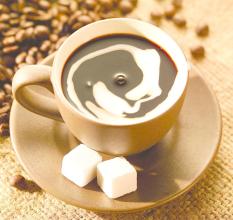Semi-automatic coffee machine pull flower flavor description grinding scale production area variety characteristics introduction
Description of drawing Flavor of semi-automatic Coffee Machine introduction to the characteristics of varieties produced by grinding scale
The first step is to make a good Espresso.
1. Grease, tiger pattern, leopard pattern, thickness
2. Acidity, smoothness, aftertaste and persistence.
The evenness, fineness and temperature of the foam are all related to the quality of the flower. No matter how bad the foam is, the pattern can be produced. The leaves don't say for the time being, and the heart is sure that there is milk running when it is poured into the ESPPRESO. If it floats in the coffee immediately, it means that the foam is playing too badly. Love, the simplest thing is to pour down from the middle, the speed is not too fast, fast 2 / 3, and shake around, but you can't "retreat". Pay attention. Just wobble left and right until the milk bubble is enough and the coffee rushes forward, then the flow rate is controlled, a little smaller, the tip of love comes out, OK, the leaves I know how to say, practice a few more times, you can sum up the experience. If you consider the cost of coffee and milk, don't use coffee when practicing, use cream and chocolate powder, cream + cold water, then beat the milk foam, pour the milk foam like 1 cup, sprinkle with cocoa powder. This is used to simulate the CMERA oil on the surface of coffee. When pouring, start from the root of the leaf (whether you turn it or not, you have to go back to this place), rush to 2 / 3, slightly increase the flow rate and shake around a few times (so the root is beautiful), then slow down the flow rate, left and right wobble backward (left and right amplitude and flow velocity decrease with it), and finally use the minimum flow rate to pull forward out of the midline. OK, it's too unreasonable not to give a score.
The first step is to understand the correct operation process of the coffee machine steam system, understand the purpose of the empty steam pipe before and after foam, and understand the importance of towels and easy cleaning in coffee making.
The second step is to learn how to use the sprinkler to touch the milk surface, the location and depth of the selected point.
Step 3 recognize the two temperatures. One is the starting and ending temperature of foaming, and the other is the temperature at which the milk foam is made. These two temperatures are very important for beginners, which is directly related to the mastery of the principle of foam. First of all, when it comes to foaming, the milk is cold at first (preferably refrigerated at 5 ℃), which can prolong the foaming time so that it can be fully foamed and delicate, and then open the steam valve to foam the milk. When foaming is consistent with our body temperature (feel neither hot nor cold), the foaming is cut off. Because our hand temperature is about 30 degrees, so I personally think that the temperature of milk foam should be between 65 and 70 degrees. Because if it is too hot, it will destroy the nutritional value of milk.

Important Notice :
前街咖啡 FrontStreet Coffee has moved to new addredd:
FrontStreet Coffee Address: 315,Donghua East Road,GuangZhou
Tel:020 38364473
- Prev

How did the water tray of Merlot's automatic coffee machine get into the coffee powder?
How did the water tray of the Merlot automatic coffee machine get into the coffee powder? please do not pour the coffee powder into the coffee powder when the coffee machine is turned off to prevent the coffee powder from entering other systems inside the machine. Two. generally speaking, the amount of coffee powder should not exceed the amount of two cups of coffee, otherwise the coffee machine will not be able to make coffee normally, and the coffee powder will remain in the machine, which will dirty the machine.
- Next

Coffee filter paper What to use Coffee filter paper What to replace
Coffee filter paper what to use coffee-coffee filter paper what to use instead of coffee can promote metabolic function, activate digestive organs, constipation has a great effect Coffee can increase high-density cholesterol, speed up the metabolism of bad cholesterol, reduce coronary atherosclerosis, reduce the risk of stroke. Drinking a cup of black coffee after a meal can effectively whiten the skin. Black coffee can also promote cardiovascular circulation low
Related
- What is the Philharmonic pressure? How to use Philharmonic pressure to make delicious coffee
- Why does a hand grinder have more fine powder than an electric grinder?
- In addition to the hot mom, what is the difference between the versions of EK43 | ditting and Mahdi ek43?
- What kind of equipment do you need to make coffee by hand? Introduction to novice starter cooking equipment tools
- Espresso needs to be ground how thick and thin scale entry Italian Coffee Machine Bean Grinder investigation and Grinding course
- How much does it cost to open a small private cafe? How much does it cost to learn coffee? How to operate it?
- The difference between the flavor characteristics of hand-brewed coffee and coffee maker is hand-brewed coffee really better than coffee maker? Can I use a coffee machine to make coffee beans by hand?
- The difference between 01 and 02 of hario v60 filter cup what is the difference between 01 and 02 filter cup opening and cooking flavor
- What's the difference between the smart cup and the French kettle? Which is better, the French kettle or the Smart Cup?
- What's the difference between a smart cup and a V60 filter cup? The difference between the taste of smart cup and hand-brewed coffee

